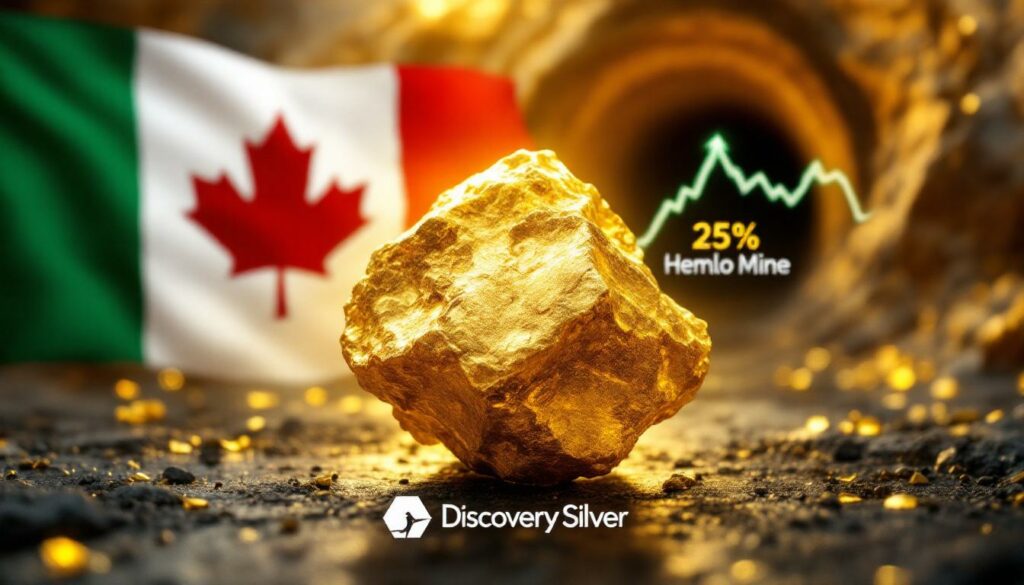Understanding Barrick Mining's Hemlo Gold Mine Sale: Strategic Implications and Market Context
In a significant development for the North American mining sector, Barrick Mining has entered advanced negotiations to sell its historic Hemlo gold mine to Discovery Silver. This potential transaction represents more than just an asset transfer—it highlights broader industry trends, market dynamics, and strategic repositioning by both companies in response to evolving gold market strategies.
What is the Hemlo Gold Mine and Why is it Being Sold?
Historical Significance of Hemlo
Located 35km east of Marathon, Ontario, near Lake Superior along the Trans-Canada Highway, the Hemlo gold mine stands as one of Canada's most storied mining operations. With a remarkable production history spanning more than three decades, this underground mining complex has yielded over 21 million ounces of gold since operations began.
The mine's strategic position along major transportation infrastructure has provided significant logistical advantages throughout its operational life, contributing to its longevity and historical importance to the Canadian mining sector. As one of Ontario's cornerstone gold operations, Hemlo has played a vital role in establishing Canada's reputation as a premier mining jurisdiction.
Mining experts note that few North American gold operations can match Hemlo's combination of production history, established infrastructure, and continued operational viability—making it a unique asset within the Canadian mining landscape.
Strategic Rationale Behind the Sale
For Barrick Mining, the decision to divest Hemlo aligns with a broader portfolio optimization strategy increasingly common among major mining companies. As Barrick's last remaining Canadian gold mine, Hemlo represents an opportunity for the company to capitalize on current market conditions while refocusing resources on larger, longer-life assets elsewhere in its global portfolio.
The timing of this potential sale appears strategically calculated, coinciding with a 25% surge in gold prices during 2025. This bullish market environment creates favorable conditions for asset monetization and mirrors similar moves by other major miners.
"Major miners including Newmont have offloaded several smaller mines during the bullion price spike, creating opportunities for mid-tier producers to expand their footprints," noted industry analysts at Mining Technology.
This sale represents a continuation of Barrick's disciplined approach to portfolio management—prioritizing tier-one assets with lower costs, longer lives, and greater scale while divesting operations that, despite their historical significance, no longer fit the company's strategic profile.
How Does This Sale Fit into Current Gold Market Dynamics?
Gold Market Conditions in 2025
The gold market in 2025 has experienced remarkable momentum, with prices climbing 25% since January. This precious metals rally has been primarily driven by a confluence of factors:
- Heightened geopolitical uncertainties across multiple regions
- Renewed trade tensions and tariff policies under President Trump's administration
- Investors seeking safe-haven assets amid global economic concerns
- Inflationary pressures in major economies
- Central bank purchasing activity
These market conditions have created an exceptionally favorable environment for gold mining companies to consider strategic transactions. With gold trading at multi-year highs, asset valuations for producing mines have correspondingly increased, creating an optimal window for companies like Barrick to maximize returns on potential divestitures.
The timing of Barrick's Hemlo sale discussions appears carefully calibrated to leverage these market dynamics, potentially commanding premium valuations that might not be achievable in different market conditions.
Mining Industry Consolidation Trends
The current wave of mining deals triggered by elevated metal prices reflects a broader industry consolidation trend. Major players are increasingly focusing on core, long-life assets while divesting smaller or non-core operations. This strategic reshuffling is reshaping the North American gold mining landscape in several important ways:
- Major miners streamlining portfolios: Companies like Barrick and Newmont are optimizing their asset bases around larger, lower-cost operations
- Mid-tier producers expanding footprints: Companies like Discovery Silver are leveraging acquisition opportunities to build scale
- Regional consolidation: Increasing concentration of assets under fewer operators in established mining districts
- Operational synergies: Acquirers targeting mines that complement existing operations
As witnessed in January 2025 when Discovery Silver acquired Newmont's Porcupine gold mine in Ontario for up to $425 million, mid-tier producers are capitalizing on divestiture strategies employed by major miners. This transaction pattern has become increasingly common as the sector undergoes a period of significant gold M&A consolidation.
Who is Discovery Silver and Why Are They Interested?
Discovery Silver's Strategic Expansion
Discovery Silver has emerged as an increasingly important player in the Americas precious metals sector. As an Americas-focused precious metals company, Discovery has been pursuing a deliberate growth strategy centered on acquiring established operations in top-tier mining jurisdictions.
The company's acquisition of Newmont's Porcupine gold mine in Ontario for up to $425 million in January 2025 signaled its serious ambitions in the Canadian gold sector. The potential Hemlo acquisition would represent a logical next step in this expansion strategy, further strengthening Discovery's presence in Ontario's established gold mining regions.
Industry analysts note several strategic benefits motivating Discovery's interest in Hemlo:
- Geographic concentration: Building a cluster of operations in Ontario creates potential operational synergies
- Diversification from silver: Expanding gold exposure balances the company's precious metals portfolio
- Established production: Acquiring operating mines reduces development risks compared to greenfield projects
- Canadian jurisdiction advantage: Leveraging Canada's stable regulatory environment and mining expertise
This potential acquisition aligns with Discovery's apparent strategy to transform from a development-focused silver company into a diversified precious metals producer with significant operating assets.
Discovery's Current Portfolio
Discovery Silver's existing portfolio centers around its flagship Cordero project in Mexico, recognized as one of the largest silver development projects globally. The company holds 100% ownership of this substantial asset, which positions Discovery as a significant player in the silver development space.
The addition of Hemlo would complement Discovery's recent acquisition of the Porcupine gold mine, creating a more balanced portfolio across:
- Commodities: Silver and gold exposure
- Jurisdictions: Mexico and Canada
- Development stages: Production assets and development projects
- Risk profiles: Operating mines and exploration upside
This portfolio diversification strategy appears designed to create a more resilient business model capable of weathering commodity price volatility while providing multiple avenues for growth. The potential Hemlo acquisition would accelerate Discovery's transformation into a multi-asset, multi-jurisdiction precious metals producer.
What Are the Details of the Potential Transaction?
Current Status of Negotiations
According to industry sources cited by Mining Technology, Barrick initiated the Hemlo sale process in April 2025, with discussions with Discovery Silver now reaching advanced stages. While significant progress has reportedly been made in negotiations, the outcome remains uncertain as neither company has officially confirmed the talks.
The transaction timeline aligns strategically with the 25% increase in gold prices analysis during 2025, potentially maximizing value for Barrick while still offering Discovery acquisition opportunities in an established mining jurisdiction.
"The parties are approaching final stages of negotiation, though the outcome remains uncertain," reported Mining Technology, citing Bloomberg as its source.
Several factors could still influence the final outcome of these discussions:
- Valuation expectations between the parties
- Due diligence findings
- Financing arrangements
- Regulatory approvals
- Community engagement considerations
Given the strategic importance of this asset—Barrick's last Canadian gold operation—negotiations are likely to involve careful consideration of various operational, financial, and community factors.
Potential Value and Structure
While specific financial terms have not been disclosed, several factors suggest the potential for a premium valuation:
- Timing advantage: The 25% gold price surge in 2025 enhances asset values
- Strategic significance: Last Canadian gold mine in Barrick's portfolio
- Established production: Ongoing operations with established systems and workforce
- Infrastructure advantages: Transportation access via Trans-Canada Highway
- Market precedent: Discovery's $425 million Porcupine acquisition establishes a reference point
The transaction structure may follow patterns established in Discovery's Porcupine acquisition, potentially including:
- Upfront cash payment
- Deferred consideration components
- Production-linked contingent payments
- Royalty provisions
- Transition service arrangements
As part of the broader industry consolidation trend, this transaction represents an important data point in understanding how the gold market surge is evolving in response to current market conditions.
What Are the Broader Implications for the Mining Sector?
Industry-Wide Portfolio Optimization
The potential Hemlo transaction exemplifies a significant trend reshaping the mining industry: strategic portfolio optimization by major producers. This trend is characterized by several key elements:
- Focus on tier-one assets: Major miners prioritizing larger, longer-life mines with lower costs
- Divestiture of non-core operations: Selling smaller or higher-cost mines that no longer fit strategic profiles
- Mid-tier expansion opportunities: Creating acquisition opportunities for growing producers
- Jurisdictional consolidation: Concentration of regional assets under fewer operators
- Capitalization on favorable prices: Timing transactions to coincide with strong metal prices
This strategic repositioning represents an important evolution in how major mining companies approach portfolio management—moving away from diversification for its own sake toward concentrated exposure to assets that drive the greatest shareholder returns.
For companies like Discovery Silver, this trend creates opportunities to acquire producing assets that may be non-core for majors but represent transformational opportunities for mid-tier producers seeking growth.
Future Outlook for Gold Mining
Looking ahead, several factors suggest the current wave of mining consolidation may continue:
- Persistent safe-haven demand: Ongoing geopolitical uncertainties supporting gold prices
- Operational cost pressures: Inflation driving strategic focus on lower-cost operations
- ESG considerations: Growing importance of environmental and social factors in asset evaluations
- Resource replacement challenges: Difficulty finding new large-scale deposits driving acquisition activity
- Portfolio rationalization continuation: Major miners likely to continue optimizing asset bases
The potential Hemlo transaction reflects these broader trends and could signal further consolidation across the North American gold mining landscape. As mid-tier producers like Discovery Silver expand through acquisitions, and majors like Barrick focus on fewer, larger assets, the industry structure continues to evolve.
For investors, communities, and industry participants, these changes present both challenges and opportunities as the sector adapts to changing market conditions and strategic priorities.
FAQ About the Hemlo Mine Sale
What makes the Hemlo gold mine an attractive acquisition target?
Hemlo offers several compelling attributes that make it an attractive acquisition target:
- Proven production history: Over three decades of continuous operation with cumulative production exceeding 21 million ounces
- Strategic location: Positioned along the Trans-Canada Highway with excellent logistics infrastructure
- Established operation: Functioning underground mining complex with experienced workforce
- Jurisdictional advantages: Located in mining-friendly Ontario with clear regulatory frameworks
- Potential optimization opportunities: Possibilities for operational improvements under new ownership
For a company like Discovery Silver seeking to build a portfolio of producing assets, these characteristics align well with acquisition criteria focused on established operations in premier mining jurisdictions.
How might this transaction impact local communities?
While specific community impact details are not addressed in available sources, mining transactions typically raise several important considerations for local stakeholders:
- Employment continuity: Potential changes in workforce requirements or operational approaches
- Economic contributions: Tax revenues, local procurement, and community investment programs
- Environmental commitments: Approach to environmental management and reclamation planning
- Stakeholder engagement: Changes in community relations practices and communication approaches
- Regional development: Long-term planning for economic activity and infrastructure
The transition from a major global miner like Barrick to a growing mid-tier producer like Discovery Silver could potentially bring different approaches to community engagement and local economic development. The specific impacts would depend on Discovery's operational plans and community relations philosophy.
What other similar transactions have occurred in the gold mining sector?
The potential Hemlo transaction follows several notable deals in the gold mining sector that illustrate broader consolidation trends:
- Discovery Silver's acquisition of Newmont's Porcupine mine (January 2025) for up to $425 million
- Newmont's divestiture of several smaller assets during the recent gold price surge
- Industry-wide portfolio optimization as major miners focus on tier-one assets
- Mid-tier producers expanding through strategic acquisitions of producing assets
These transactions collectively demonstrate the ongoing reshaping of the North American gold mining landscape, with assets changing hands from major producers to mid-tier companies seeking growth and scale. The Hemlo transaction would represent another significant example of this important industry trend.
Further Exploration
Readers interested in learning more about gold mining industry trends can also explore related educational content from Mining Technology, which offers industry news and analysis on mining sector developments and precious metals markets. Furthermore, understanding the relationship between gold stock market guide cycles can provide valuable context for evaluating these industry consolidation trends.
Are You Looking for the Next Major Mineral Discovery?
Stay ahead of the market with Discovery Alert's proprietary Discovery IQ model, which instantly notifies investors about significant ASX mineral discoveries and turns complex data into actionable insights. Explore historic examples of exceptional returns from major discoveries by visiting the Discovery Alert discoveries page and start your 30-day free trial today.




